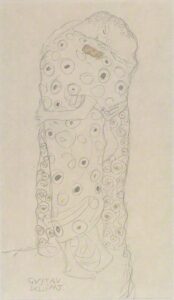
Gustav Klimt. Standing Pair of Lovers
by Loretta Pettinato in Brescia
Translated by Laura Pettinato

Starting from January 2020, various Italian cities began promoting different cultural initiatives which revolve around the female universe, to pay tribute to women. Inside the Martinengo Palace in Brescia an exhibition has been organized with artwork from 1500 to 1900, entitled Women in Art. There are 90 paintings by artists such as Tiziano, Guercino, Boldini as well as lesser known artists like Appiani, Palizzi and Sassoferrato. These canvases, which all come from private collections, portray both human and artistic scenes, experienced by women in different eras and social classes, revealing their working and domestic life, religion and sensuality. The subjects include both biblical heroines and queens, commoners and gentlewomen, saints and sinners. Next to a Maddalena Penitente by Tiziano and a Santa Caterina da Siena by Sassoferrato, one can admire the Standing Pair of Lovers by Klimt and other beautiful and sensual women by Boldini and Appiani.
Giovanni Boldini, a famous portraitist, immortalized middle-class women wearing refined dresses, as well as transgressive women who posed naked in order to exhibit their perfect bodies, as in the painting Calze Nere. Andrea Appiani, who was among Napoleon’s favourite artists, is also present in this exhibition with his painting Ritratto di Francesca (1803). Francesca, known as Fanny, was a noblewoman from Brescia who abandoned her husband to flee with her lover. The portrait highlights her attractiveness: a supple body, black hair and eyes, and a slight hint of a smile.
Very different are the paintings showing women’s occupations, which in many cases were dangerous and humiliating. Glisenti captured young peasant brides, who throughout the 19th century were obliged to be submissive to their mothers-in-law, almost a form of slavery. Other paintings represent women performing very tiring jobs, like in Palizzi’s painting Donne che scavano a Pompei, where barefoot girls carry baskets full of rocks and debris on their shoulders (1870).
Whenever jobs were unavailable, there were female beggars, portrayed while holding a sort of poverty certificate, which allowed them to panhandle. The exhibition also has a small but interesting section dedicated to women artists: here one finds Cleopatra morsa dall’aspide by Artemisia Gentileschi, in which the queen’s marmoreal white body stands out on the canvas’ black background, as well as a few works by Orsola Caccia, a lesser known self-taught artist, but still a passionate painter who kept making art even after being locked away in a convent.

This exhibition is interesting both for the quality and the quantity of the canvases. What really moves the spectators is what these works narrate, the long path followed by women from the 16th century onwards. This path is often painful and covered in pitfalls and even though progress was made, the final goal still hasn’t been reached. The goal is to eliminate many grey areas, which make life more problematic for the part of society known as ‘half the sky’.
Volume 34 no 6 July / August 2020

